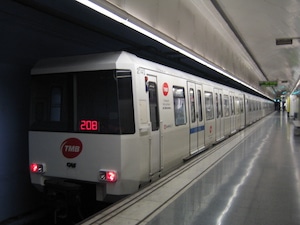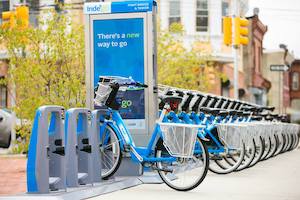The Joys of the One-Way Run
by Mark Lowenstein
Most planned runs are ‘out and backs’ or loops, since you’ve usually got to end up where you started. But once in a while, in the right place and with the right infrastructure and planning, the one-way run can be a wonderful and rewarding experience. The advantage of the one-way run, especially if it’s on an attractive route, is that you get to do more of the best stuff rather than turning back prematurely or having to design a sub-optimal back half loop. As an example, this past April, I did a great one-way run in Chicago, enjoying about 8 miles along the Lakefront Path, using a Divvy bike (Chicago’s bike share company) for the return.
In this piece, I share some strategies for planning a one-way run, and then list a sample of iconic one-way runs from major cities…to whet your appetite!
How To Plan A One-Way Run
There are all sorts of ways to make a one-way run happen, but here are a few strategies, which naturally are situational.
- The partner pick-up or drop off. Maybe in your hometown this allows you to ‘run home’ from a favored spot. In a new place, perhaps it allows for greater discovery or a more favored route. Of course this requires a willing partner!
- The “two-car” approach. This is a tried and true strategy of hikers and trail runners who might want to do a through trail or a different descent than ascent. Boaters also use this for the one-way ‘float’ down a river. But runners can use this too! Of course, two cars and a partner are required…
Public Transport. In places with good public transportation, it’s fun to plan a one-way run and then let the bus or subway zip you back. Just about all major European cities, for example, have good enough public transport that pretty much changes the game for running. Perhaps avoid doing this on really hot and humid, out of respect for your fellow passengers…
- Uber Back. This is always an option, of course. Recommend an extra tip if you’re particularly sweaty or smelly.
Pro Tip for Hot Days: If using public transportation or Uber/Lyft to enable the one-way run, you might consider taking the Uber/transport OUT rather than for the return, as a ‘courtesy’ to your driver/fellow train & subway passengers.
- Bike Share. This involves using a bike share program for one of the directions. It’s a good option, but requires some planning in terms of knowing station locations. The bike part can be an extra part of the workout — advantage or disadvantage? One thing that’s a factor here is that in cooler temps, different clothing might be required for the ‘bike’ potion. Pro tip: If not using the app, remember to bring your credit card!
Some Classic One-Way Runs
While there are countless possibilities for one-way runs in places that have the right infrastructure for it, here are some fantastic options in top running cities to add to your bucket list!
New York: Hudson River Greenway. Public transportation allows for a fantastic one-way run between the George Washington Bridge and Lower Manhattan.
Boston: Emerald Necklace. The subway system (called ‘The T’) allows one to run the entire 10-mile trail from the State House to Franklin Park.
Chicago: Lakefront Trail. Takes some planning. Use Metra or Divvy Bike Share to do as much of this 18-mile trail.
Philadelphia: Schuylkill River Trail to Fairmount Park. The Indego bike share service allows for an iconic longer-distance Philly run.
Dallas: Katy Trail. Believe it or not, a public transport enabled one-way run in this car-centric city! Take the Katy Trail from downtown, enjoy a snack or a smoothie at the lifestyle shopping center at the northern end, and take the light rail back from SMU/Mockingbird.
San Diego: The Coaster. A train runs along the Coast Highway between Solana Beach and Oceanside, allowing for a one-way beach or coast run of up to 16 miles!
Amsterdam: Amstel River to Ouderkerk aan de Amstel. Wonderful one-way run along the river, up to 16 km one-way, including the lake loop. Use the 300 bus from town to the Bijlmer Arena metro station.
Barcelona: Waterfront & Beaches. Numerous transport options enable the full 9-10 km one-way run along Barcelona’s scenic waterfront.
Frankfurt: Main River to Hanau. Allows for a run of up to 15 km along the river from Frankfurt east to Hanau. Take the train back from Hanau West or Steinheim.
London & Paris: River Paths. Running along the Thames and the Seine are among the classic urban runs of the world. There’s public transport within a couple of blocks of these paths. These long river run options apply to most major cities in Europe (click our classic river runs category).
Kyoto: Kamo River Paths. The most popular run in Kyoro. Good transport enables a run of up to 19 km one-way.
Tokyo: Tama River Trail. One of the best options for a longer uninterrupted run in Tokyo. Run for up to 30 km, with good transport options for the return.
Seoul: The Seoul Metro allows one to do a portion of the challenging, 19 km Old City Wall loop path. The Metro also follows the 11 km Cheonggyecheon Stream path, which runs below the roadway for 11 km, passing under 22 bridges!
Taipei: Keelung River Paths. The left bank option provides the best access to the MRT system for a run of up to 9 km one-way.
Vienna: Danube Island. It’s nearly 22 km one-way from tip to tip on the Donauinsel, which can be combined with other paths along the Danube. Good metro options as far as Donaustadtbrücke, and bus options further south.
National Park Shuttle Buses. Many of the most popular national parks have instituted a shuttle bus system along their main roads during high season. This is a boon to runners! There’s no auto traffic to contend with, and the shuttles allow for great one-way options. A few favorites:
- Zion National Park: Run the entire 10 km Zion Canyon Scenic Drive.
- Acadia National Park: Use the shuttle to do a portion of the 27-mile loop road.
- Grand Canyon National Park: A shuttle bus runs along the South Rim.

 Public Transport. In places with good public transportation, it’s fun to plan a one-way run and then let the bus or subway zip you back. Just about all major European cities, for example, have good enough public transport that pretty much changes the game for running. Perhaps avoid doing this on really hot and humid, out of respect for your fellow passengers…
Public Transport. In places with good public transportation, it’s fun to plan a one-way run and then let the bus or subway zip you back. Just about all major European cities, for example, have good enough public transport that pretty much changes the game for running. Perhaps avoid doing this on really hot and humid, out of respect for your fellow passengers…
